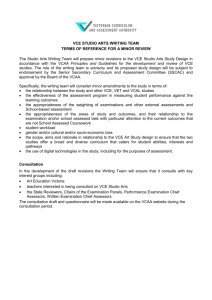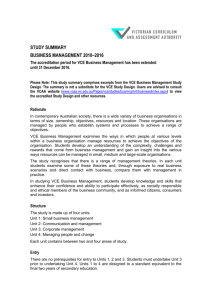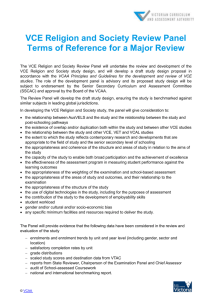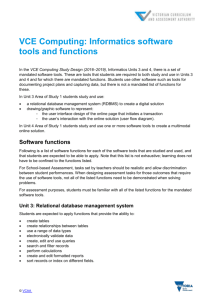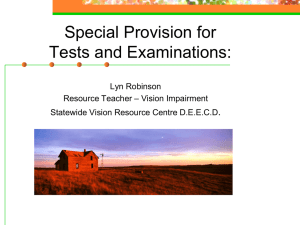VCE ENVIRONMENTAL SCIENCE Summary of proposed changes
advertisement
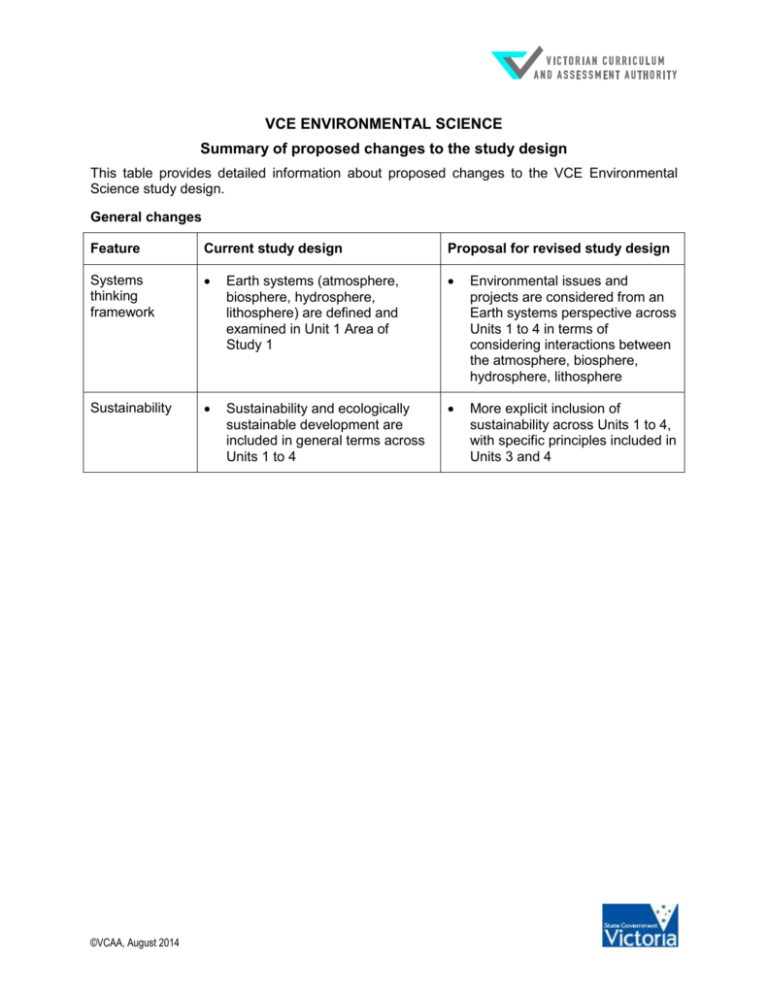
VCE ENVIRONMENTAL SCIENCE Summary of proposed changes to the study design This table provides detailed information about proposed changes to the VCE Environmental Science study design. General changes Feature Current study design Proposal for revised study design Systems thinking framework Earth systems (atmosphere, biosphere, hydrosphere, lithosphere) are defined and examined in Unit 1 Area of Study 1 Environmental issues and projects are considered from an Earth systems perspective across Units 1 to 4 in terms of considering interactions between the atmosphere, biosphere, hydrosphere, lithosphere Sustainability Sustainability and ecologically sustainable development are included in general terms across Units 1 to 4 More explicit inclusion of sustainability across Units 1 to 4, with specific principles included in Units 3 and 4 ©VCAA, August 2014 VCE ENVIRONMENTAL SCIENCE SUMMARY OF PROPOSED CHANGES Specific changes Section Current study design Proposal for revised study design Scope of study A single Rationale covers both proposed Scope of study and Rationale Explains aspects of the broad field of environmental science that is included in VCE Environmental Science Rationale Explains the importance of studying VCE Environmental Science, including post-secondary pathways Aims Includes a set of eight VCE Environmental Science aims Proposes a set of two aims specific to VCE Environmental Science and a set of seven generic aims which apply to all VCE sciences (Biology, Chemistry, Environmental Science, Physics and Psychology) Key science skills A set of key skills is listed specific to each Area of Study A set of key science skills is described under seven general headings which apply to all VCE sciences across Units 1 to 4, with elaborations specific to VCE Environmental Science Unit questions Unit titles Unit 1: The environment Unit 2: Monitoring the environment Unit 3: Ecological issues: energy and biodiversity Unit 4: Ecological sustainability Unit questions designed to link concepts and ideas across the unit and to reflect the inquiry nature of science Unit 1: How are Earth systems connected? Unit 2: Is pollution avoidable? Unit 3: How can Earth systems be managed? Unit 4: Can Earth systems adapt to change? Area of study questions Area of study has short phrases as titles Area of study has questions as titles which are designed to enable exploration of the concepts and ideas related to the topics within the area of study Key knowledge sub-headings Key knowledge listed as a set of dot points Key knowledge dot points listed under sets of sub-headings ©VCAA, August 2014 2 VCE ENVIRONMENTAL SCIENCE SUMMARY OF PROPOSED CHANGES Section Current study design Unit 1 Area of Study 1 The environment How does Earth sustain life? Topics: concepts of environment, ecosystem, components and Earth’s major systems processes processes for creating the the Sun as a source of energy for essential conditions for life on life Earth components and structures of inputs for life the hydrosphere, lithosphere, outputs of life atmosphere and biosphere Content is similar to current content in biogeochemical cycles Unit 1 Area of Study 1: stronger focus on the connections between Earth’s four systems expected key knowledge is more specific Unit 1 Area of Study 2 Environmental change characteristics and distribution, causes and effects of humaninduced environmental changes human-induced changes that contribute to the conservation and remediation of the environment ©VCAA, August 2014 Proposal for revised study design Does Earth change in predictable ways? Topics: systems thinking environmental factors that affect Earth over time Content is similar to Unit 1 Area of Study 2 and Area of Study 3, except that: there is a stronger focus on the connections between Earth’s four systems. Victorian ecosystem characteristics have been deleted time-frames for environmental change have been specified, and medium-term effects have been included students will study selected examples of change over different timeframes distinction between open, semipermeable and closed systems is included 3 VCE ENVIRONMENTAL SCIENCE SUMMARY OF PROPOSED CHANGES Section Current study design Proposal for revised study design Unit 1 Area of Study 3 Ecosystems interactions between organisms distinguishing characteristics of Victorian ecosystems natural short-term cyclic environmental changes natural long-term cyclic environmental changes natural random environmental changes Practical investigation into the monitoring of ecosystems or their components and/or change in ecosystems new area of study with a skills focus investigation question relates to content in Unit 1 Areas of Study 1 and/or 2 student designed and conducted laboratory and/or practical work Unit 2 Area of Study 1 Environmental indicators types of environmental indicators for pollution and ecological health of ecosystems ecological niche physical, chemical, biological environmental indicators for an ecosystem or environmental issue When does pollution become a hazard? Topics: characteristics, sources and transport mechanisms of pollutants measurement and monitoring of pollutants treatment of pollutants Content is similar to current Unit 4 Area of Study 1 except that: there is a focus on differentiating between wastes, pollutants and contaminants, and understanding how pollutants cause adverse effects on living and environmental systems students select a bioaccumulant and a water- or air-borne pollutant as a focus study new inclusion related to contemporary technologies that reduce pollution ©VCAA, August 2014 4 VCE ENVIRONMENTAL SCIENCE SUMMARY OF PROPOSED CHANGES Section Current study design Proposal for revised study design Unit 2 Area of Study 2 Using environmental indicators characteristics, distribution, causes and effects of a selected local example of environmental degradation or environmental issue environmental indicators used to monitor environmental degradation or environmental issue role of monitoring program on environmental degradation or environmental issue role of government policies and regulatory bodies in pollution control use of indicators by governments and regulatory bodies, and in State of the Environment reporting How is pollution managed? Students choose a question related to each of: air pollution water pollution soil pollution They compare sources, properties, movement through Earth’s spheres, measuring and monitoring, effects on living things and the environment, and treatment and management options. The focus is on pollution at national and global levels. The content is related to current elements of Unit 2 Area of Study 2 in terms of environmental monitoring, but applies specifically to pollution management. However, there is a decreased focus on examining government and regulatory body policies. Related content from Unit 4 Area of Study 1 related to mechanisms of pollutant action is also included. Unit 2 Area of Study 3 Case study involving the management of a selected pollutant of local interest. This is similar to the current requirement in Unit 4 Area of Study 1 Unit 3 Area of Study 1 Energy and global warming definitions and applications of scientific concepts and principles of energy fossil and non-fossil fuel resources renewable and non-renewable energy sources natural and enhanced greenhouse effect, greenhouse gases contribution of human activities to enhanced greenhouse effect, impacts and mitigation strategies ©VCAA, August 2014 Not included Is maintaining biodiversity worth a sustained effort? Topics: importance of biodiversity biodiversity change over time measuring changes in biodiversity threats to biodiversity production and restoration of biodiversity Content is similar to that of the current Unit 3 Area of Study 2. Specific sustainability principles have been included. 5 VCE ENVIRONMENTAL SCIENCE SUMMARY OF PROPOSED CHANGES Section Current study design Proposal for revised study design Unit 3 Area of Study 2 Diversity in the biosphere types, significance and value of biodiversity conservation categories assessment of biodiversity threats to biodiversity assessment of threat in determining conservation categories methods of protecting environments and managing populations use of scientific data to establish biodiversity treaties, agreements and regulatory frameworks environmental impact assessment precautionary principle Is development sustainable? Pollution and health general characteristics of mercury and sulfur dioxide as pollutants characteristics of one pollutant (excluding mercury and sulfur dioxide) Will Earth run out of energy? Topics: fossil fuels comparison of different energy sources use of science to reduce the impacts of energy use Unit 4 Area of Study 1 Students use principles related to sustainability and environmental management to evaluate a selected environmental science project. Content is similar to that of the current Unit 4 Area of Study 2, except that: different definitions of sustainability and ecologically sustainable development are explored specific sustainability principles are included Content similar to current Unit 3 Area of Study 1 except that: greenhouse effects not considered as part of this area of study, since it is part of the proposed Unit 4 Area of Study 2 specific sustainability principles are included new content includes environmental rehabilitation of sites where energy sources are extracted, strategies for increasing energy conversion efficiency, projections of future energy needs ©VCAA, August 2014 6 VCE ENVIRONMENTAL SCIENCE SUMMARY OF PROPOSED CHANGES Section Current study design Proposal for revised study design Unit 4 Area of Study 2 Applied environmental science assessment of environmental risks and impacts of a selected environmental science project ecologically sustainable development environmental management tools and strategies influence and consequences of regulatory frameworks roles of community, media, environmental interest groups, non-government and/or government agencies in encouraging responsible environmental practices Is climate predictable? Topics: major factors that alter Earth’s atmosphere measurements of the atmosphere that give useful information about changes in the climate consequences of changing the composition of gases in the atmosphere Practical investigation related to biodiversity or energy use from an environmental management perspective new area of study with a skills focus investigation question relates to content in Units 3 and/or 4 may be undertaken in either Unit 3, Unit 4 or across both Units 3 and 4 student designed and conducted may involve collection of primary and/or secondary data results presented as a scientific poster may be undertaken in either Unit 3, Unit 4 or across both Units 3 and 4 Unit 4 Area of Study 3 ©VCAA, August 2014 Not included Much of the content of this area of study is new, but includes greenhouse effects as is currently in Unit 3 Area of Study 1 A new focus includes the interpretation of climate data and the associated uncertainties associated with predictions 7 VCE ENVIRONMENTAL SCIENCE SUMMARY OF PROPOSED CHANGES Section Current study design Proposal for revised study design Units 3 and/or 4 scientific poster template Not included Scientific poster template provided which includes identified sections and suggested marking scheme Practical logbook Not included Students are required to maintain a practical logbook for record, authentication and assessment purposes Schoolassessed Course School-assessed Coursework is weighted across four outcomes Proposed School-assessed Coursework is equally weighted across 5 outcomes ©VCAA, August 2014 8 VCE ENVIRONMENTAL SCIENCE SUMMARY OF PROPOSED CHANGES ASSESSMENT Units 1 and 2 Assessment tasks in the current and proposed study designs are similar. Some have been updated to reflect current assessment practice and the nature of the discipline, while more specific tasks are prescribed for some outcomes. Current Unit 1 assessment tasks Proposed Unit 1 assessment tasks Assessment tasks for this unit are: • fieldwork and reports • oral presentations • practical activities • practical reports • reports in multimedia and/or poster format • tests. Assessment tasks for this unit are: For Outcomes 1 and 2: A selection from the following: fieldwork report report of a practical activity involving the collection of primary data annotations of a practical work folio of activities or investigations research investigation involving the collection of secondary data model of an aspect of Earth systems logbook of practical activities analysis of data/results including generalisations/conclusions media analysis/response problem solving involving environmental science concepts, skills and/or issues test comprising multiple choice and/or short answer and/or extended response reflective learning journal/blog related to selected activities or in response to an issue The assessment tasks may be written, oral or multi-modal. and For Outcome 2: case study that demonstrates how changes have affected a specific area over different time scales, showing the interrelationships and interactions of processes that occur over different time scales at a location. The assessment task may be written, oral or multi-modal. ©VCAA, August 2014 9 VCE ENVIRONMENTAL SCIENCE SUMMARY OF PROPOSED CHANGES Current Unit 2 assessment tasks Proposed Unit 1 assessment tasks Assessment tasks for this unit are: • fieldwork and reports • oral presentations • practical activities • practical reports • reports in multimedia and/or poster format • tests. For Outcomes 1 and 2: A selection from the following: report of a fieldwork exercise report of a practical activity involving the collection of primary data research investigation involving the collection of secondary data annotations of a practical logbook of activities or investigations analysis of data/results including generalisations/conclusions model of an aspect of Earth systems media analysis/response problem solving involving environmental concepts, skills and/or issues test comprising multiple choice and/or short answer and/or extended response reflective learning journal/blog related to selected activities or in response to an issue and For Outcome 2: a comparison of the sources, nature, transport mechanism, effects and treatment of three selected pollutants, with reference to their actions in the atmosphere, biosphere, hydrosphere and lithosphere. The assessment task may be written, oral or multi-modal. and For Outcome 3: a report of a case study involving the management of a selected pollutant of local interest. The assessment task may be written, oral or multimodal.data analysis test comprising multiple choice and/or short answer and/or extended response. The assessment tasks may be written, oral or multimodal. and For Outcome 3: • a report of a student-designed quantitative laboratory investigation using an appropriate format, for example, digital presentation, oral communication, scientific poster or written report. ©VCAA, August 2014 10 VCE ENVIRONMENTAL SCIENCE SUMMARY OF PROPOSED CHANGES Proposed Unit 3 Assessment The nature of assessment tasks in the current and proposed study designs is similar, although some assessment tasks have been updated to reflect current assessment practice and the nature of the discipline. The number of mandated tasks has been reduced from four to two. An indication of time for the task is intended to provide greater comparability in the scope of the tasks across classes and schools, and to reduce School-assessed Coursework load for teachers and students. Outcomes Outcome 1 Explain the importance of Earth’s biodiversity, analyse the threats to biodiversity, and evaluate management strategies to maintain biodiversity in the context of one selected threatened endemic species. Outcome 2 Apply the principles of ecologically sustainable development and environmental management to evaluate environmental science projects, including a focus on one selected environmental science project. Total marks Marks allocated* 50 50 Assessment tasks A report on the conservation of one selected threatened native species The assessment task may be written or multi-modal. (up to 1000 words) An evaluation of a selected environmental science project. The assessment task may be written, oral or multi-modal. (approximately 50 minutes) 100 *School-assessed Coursework for Unit 3 contributes 20 per cent. ©VCAA, August 2014 11 VCE ENVIRONMENTAL SCIENCE SUMMARY OF PROPOSED CHANGES Proposed Unit 4 Assessment The nature of proposed assessment tasks has been broadened for Outcomes 1 and 2. An indication of time or word limits for the tasks is intended to provide greater comparability in the scope of the tasks across classes and schools, and to reduce School-assessed Coursework load for teachers and students. The proposed Outcome 3 task may be undertaken in Unit 3, Unit 4, or across Unit 3 and Unit 4, but will be reported as part of Unit 4 School-assessed Coursework. A template has been constructed for production of the associated scientific poster task to assist in staged completion and authentication of student work. Outcomes Outcome 1 Compare the advantages and disadvantages of a range of energy sources, evaluate the sustainability of their use, and discuss the impacts of their use on society and the environment. Outcome 2 Explain the causes and effects of changes to Earth’s climate, compare methods of measuring and monitoring atmospheric changes, and discuss the impacts of atmospheric changes on living things and the environment Marks allocated* 30 30 Assessment tasks At least one task selected from: annotations of at least two practical activities from a practical logbook report of a student investigation model of energy concepts evaluation of research media analysis/response analysis of data including generalisations and conclusions response to structured questions reflective learning journal/blog related to energy concepts (approximately 50 minutes) At least one task selected from: annotations of at least two practical activities from a practical logbook report of a student investigation model of climate concepts evaluation of research media analysis/response analysis of data including generalisations and conclusions response to structured questions reflective learning journal/blog elated to climate concepts (approximately 50 minutes) continued ©VCAA, August 2014 12 VCE ENVIRONMENTAL SCIENCE Outcome 3 Design and undertake an investigation related to biodiversity or energy use from an environmental management perspective, and present methodologies, findings and conclusions as a scientific poster. Total marks SUMMARY OF PROPOSED CHANGES 30 Structured scientific poster according to VCAA template (not exceeding 1000 words) 90 *School-assessed Coursework for Unit 4 contributes 30 per cent. ©VCAA, August 2014 13


